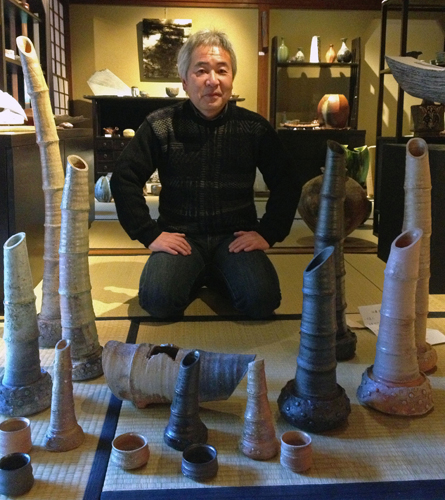Kato Takahiko: Shigaraki Ceramic Artist 加藤隆彦の陶芸〜信楽焼の世界

|
Shigaraki, like many styles of Japanese pottery, is also the name of the town in which it originated. Located not far from Kyoto, it could have been the capital of Japan if, in 745, Emperor Shomu’s consul hadn’t persuaded him to move from Shigaraki to Nara. Nonetheless, pottery took root there and the flames have continued to burn in anagama (wood-burning tunnel kilns) ever since. With such a long and celebrated history one would expect to find dozens of potters today carrying the torch of tradition, but unfortunately this isn’t the case. There are only a handful of truly outstanding Shigaraki ceramic artists these days and one of the best, most innovative and original surely has to be Kato Takahiko (b.1952). Born and raised in Shigaraki, Kato deeply respects and looks for inspiration in the ancient masterpieces, those being made mostly in the 15th through 16th centuries. As he told me, “I’ve studied and copied all the forms that Shigaraki is known for— the large farmer’s jars (tsubo), small squat jars (uzukumaru), and huge open-mouthed vats (kame) from centuries ago— yet I’m alive today and want to add my own forms and voice to the Shigaraki.” When visiting Shigaraki one does see many utsushi—or copies—of the masterpieces of ages past (as well the ubiquitous tanuki statues). That’s all fine, but Kato has ventured into new creation. Kato brings out the characteristics that Shigaraki is world-renowned for in his three-day 24/7 firings; those being tsuji-aji (‘clay flavor’), bidoro (vitrified glassy rivulets that streak across works, often forming emerald-toned beads), hi-iro (fire colored tones) and shizen-yu (natural ash-glazes that can be smooth or very crusty). Take a look at the ribbed, wavy or winged vessels here. They have an abundance of energy that don’t take away from Shigaraki’s defining characteristics. Some are even spooky, as if they have come from an ancient dinosaur realm or some dungeon. He also does classical forms with an added twist, as can be seen in the chawan (tea bowl) where he’s added a stone-like texture over the Koetsu-inspired form. The warm orange glow emitting from the chawan is soothing, and compliments the hues of whipped emerald green tea. Shigaraki has never had a Living National Treasure before, unlike say Bizen where they’re now on number five. I would like to nominate Kato as the first Shigaraki Living National Treasure for his mastery of the old and creation of the new. Regardless of whether Kato is some day designated, for me he already is a Shigaraki treasure unlike no other. |
陶磁器には様々なスタイルがあるが地名がそのまま名前になっている場合がほとんどで、信楽焼はその名の通り、滋賀県甲賀市信楽が中心である。745年(天平17年)当時はこの地に都があった。もし臣下の者たちが聖武天皇に奈良に戻ることを進言していなかったらここが現在の首都になっていたかもしれない。都は移されたがその後この地で信楽焼は生まれ、特徴ある窖窯(あながま)の伝統が今日まで守られてきた。長い歴史からすればそのスタイルを現代に受け継ぐ陶工もさぞかし多かろうと思うが、実際には信楽焼の陶工は決して多くない。その中でも最も革新的で独創性に溢れているのが加藤隆彦(1952年生まれ)である。 信楽に生まれ育った加藤は特に15世紀から16世紀にかけて生まれた古い名品が持つ味わいと創造性に深い敬意を払っている。「これまで信楽焼のあらゆる形を研究してきました。その中には何世紀も前に作られた大型の壺、人がうずくまっている姿を連想させる蹲(うずくまる)、巨大な甕などがあります。その上で私独自の形を追求し、伝統の信楽焼に新しい味わいを付け加えたいと思っています」。信楽を訪れると、古くからの名作を模倣して作られた作品や、信楽焼の代名詞のようになっているタヌキの置物に到る所で遭遇する。それらはそれなりに魅力的だが、加藤の新たな挑戦は独自の大変魅力的な作品を生み出している。 加藤は三日三晩焼き続けて信楽焼の魅力を引き出す。土味(つちあじ)、ビードロ釉(作品の表面にガラスが溶けて流れたようなエメラルド色のビーズを作る)、火色(緋色)、そして自然釉の付着、といった特徴によって信楽焼独特の焼き上がりとなる。 薄い翅状の形態を持った一連の作品を見てみよう。エネルギーに満ちた表現で、信楽焼の特徴もしっかりと備えている。中には恐竜の形や、牢獄の格子を連想させるような、少々不気味な感じさえする作品もある。一方、伝統的な形にひと工夫加えた茶碗はあたかも本阿弥光悦の作品を参考にして石のような感触を加味したかような仕上がりである。茶碗が放つ温かみのあるオレンジ色の輝きが観る者の心を和ませ、同時に抹茶の色を引立てている。 信楽焼の世界から人間国宝が出たことは無い。備前焼からは5名もの人間国宝が出ているのに、である。伝統に精通した上で新しいものに挑戦している加藤を信楽焼の初の人間国宝として推薦したい。いつか実際にその日が来るのかもしれないが、彼がすでに他に類をみないほどの、信楽焼の宝であることは間違いない。 |








